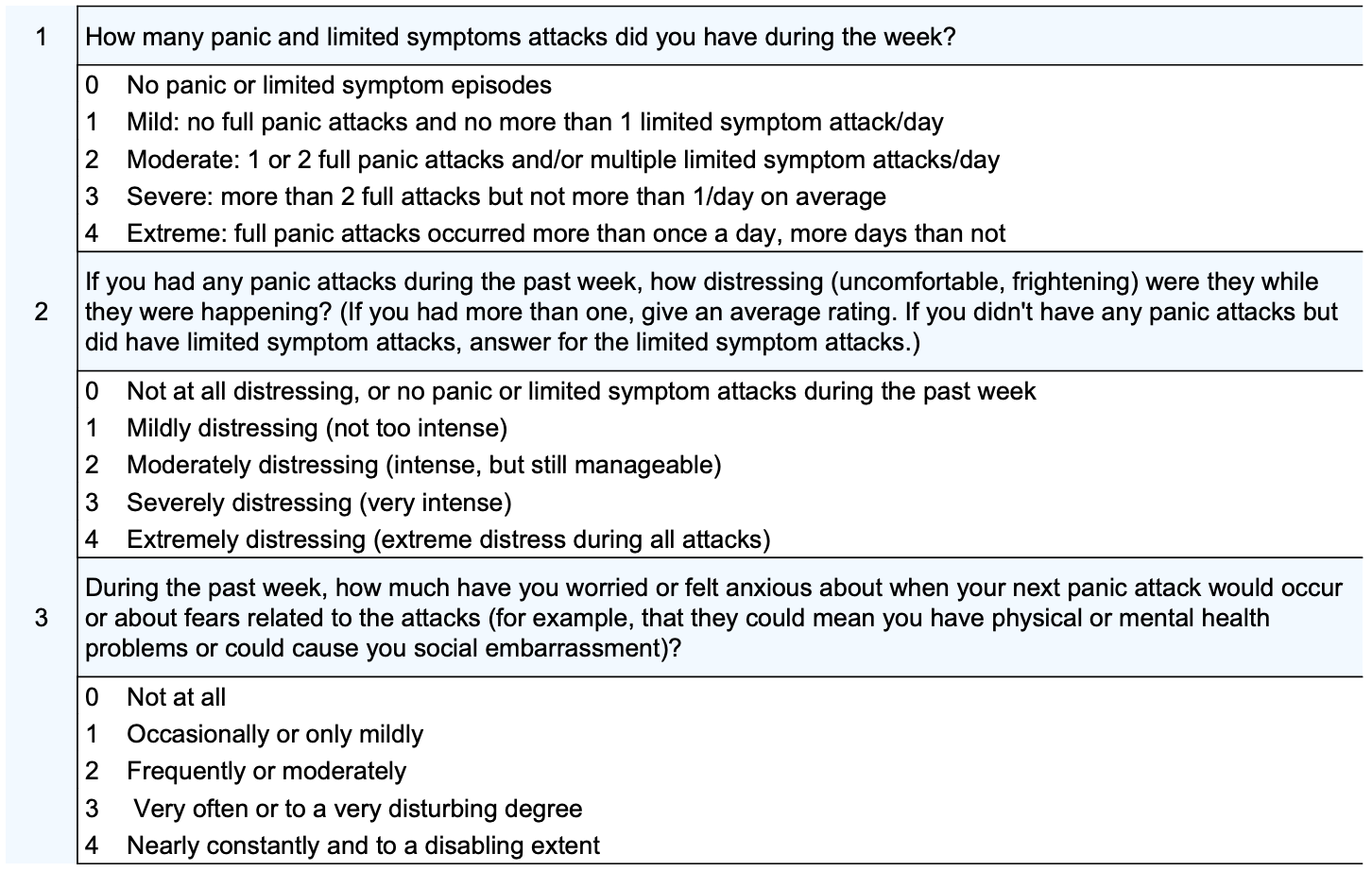The Panic Disorder Severity Scale (PDSS) is a self report scale that measures the severity of panic attacks and panic disorder symptoms. It is appropriate for use with adolescents (13+) and adults.
The scale is a useful way of assessing overall panic disorder severity at baseline, and it provides a profile of severity of the different panic disorder symptoms. It is a good monitoring tool because it is brief and sensitive to change, and can be used to track symptoms over time.
The scale consists of seven items, each rated on a 5-point scale. The items assess panic frequency, distress during panic, panic-focused anticipatory anxiety, phobic avoidance of situations, phobic avoidance of physical sensations, impairment in work functioning, and impairment in social functioning.

Raw scores range from 0 to 28 and composite scores range from 0-4. A composite score is established by averaging the scores of the seven items. This composite score indicates, on average, how the test taker responded to each question, higher scores indicating a higher severity of panic disorder.
A raw score of 9 and above suggest the need for a formal diagnostic assessment for panic disorder. Scores are sensitive to change after psychological treatment.
Evaluation of internal consistency in 198 patients with panic disorder yielded a Cronbach’s alpha of 0.64. Joint reliability ranged from 0.84 to 0.88 for trained raters. The PDSS total score showed moderate correlations with both panic disorder severity ratings of the Anxiety Disorders Interview Schedule–Revised (ADIS-R) (r = 0.54) (DiNardo and Barlow 1988) and severity ratings of the Clinical Global Impression (CGI) Scale (r = 0.66).
Individual PDSS item scores were strongly associated (r = 0.60–0.78) with ADIS-R items of similar content and less strongly associated (r = 0.35–0.47) with CGI Scale and ADIS-R severity ratings. The PDSS items most highly correlated with similar ADIS-R items were panic frequency (r = 0.71), anticipatory anxiety (r = 0.78), agoraphobic fear and avoidance (r = 0.73), and sensation fear and avoidance (r = 0.69). The PDSS total score was not significantly correlated with that of the Hamilton Rating Scale for Depression (Ham-D) (r = 0.11). The PDSS has proved to be sensitive to change with treatment.
Shear, M.K., Brown, T.A., Barlow, D.H., Money, R., Sholomskas, D.E., Woods, S.W., Gorman, J.M., Papp, L.A. (1997). Multicenter collaborative Panic Disorder Severity Scale. American Journal of Psychiatry, 154, 1571-1575.
Shear MK, Brown TA, Barlow DH, Money R, Sholomskas DE, Woods SW, Gorman JM, Papp LA. Multicenter collaborative Panic Disorder Severity Scale. American Journal of Psychiatry 1997;154:1571-1575
Houck, P. R., Spiegel, D. A., Shear, M. K., & Rucci, P. (2002). Reliability of the self-report version of the panic disorder severity scale. Depression and Anxiety, 15(4), 183-185.
Wuyek LA, Antony MM, McCabe RE. Psychometric properties of the panic disorder severity scale: clinician administered and self report versions. Clinical Psychology & Psychotherapy. 2011;18(3):234-243.
NovoPsych’s mission is to help mental health services use psychometric science to improve client outcomes.
© 2023 Copyright – NovoPsych – All rights reserved